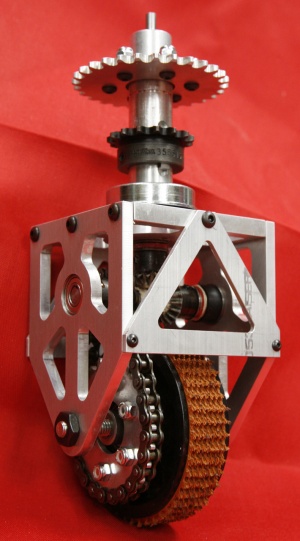DEWBOT VI Drive Train
- Its superior maneuverability. This should be especially valuable in aligning with soccer balls and with the goal.
- Safety while crossing the bump. A 6wd robot would tilt over further during the climb and would also experience two tipping points. The second of these (coming off the flat top of the bump) will put the robot at a considerable tipping risk unless center of mass (CoM) is very low.
DEWBOT VI is able to safely cross the bump and also drive through the tunnel. For both of these actions, the robot will need to drive in its long (x) axis direction. Chassis orientation is important for us in BREAKAWAY. The robot will not be capable of driving along the top of the bump.
Contents
Pivots
Pivots are co-axially driven and can be rotated infinitely. All (4) pivots are identical.
Pivot bodies are machined 6061 aluminum. Machining was graciously provided by Wamac, Inc., a Downingtown Area Robotics sponsor.
(3) thrust bearings are used in each pivot to bear rotating axial loads (including one bearing the robot’s weight). (2) roller bearings and (6) ball bearing races are used to bear each pivot’s rotating radial loads.
Drive
Each wheel is independently driven, with each drive design being identical. A CIM motor provides the drive power to each wheel via the following drive-train:
- The CIM drives a 9T Type 35 sprocket on its shaft
- driving the Pivot Drive Chain
- which drives the 28T Pivot Drive Sprocket
- which turns the Coaxial Drive Shaft from its top
- turning a 16T Drive Miter Gear at its bottom
- which drives the 16T Transfer Shaft Miter Gear
- thereby turning the Transfer Shaft
- and the 9T Transfer Shaft Sprocket
- driving the Wheel Drive Chain
- which drives the Wheel via the attached 24T Wheel Drive Sprocket
There is no Gearbox. All reduction is accomplished using chains and sprockets (the Miter Gears are 1:1). This makes an unusual noise. Overall reducion is (28/9)x(24/9) = 8.30. Maximum robot speed is 9.8 ft/s.
All chains are Type 35 steel.
Unlike tank drives, all CIM motors drive in the same direction, so there is no left-to-right mismatch between motors' clockwise and counterclockwise performances.
Steering
Pivot angles will be measured using magnetic absolute encoders which actually measure the steering motor drive angle, but since drive and driven sprockets are both 15T, this should provide accurate angle values.
Chassis
Wheelbase is 28” (x) x 21.5” (y). CoM is 9” above grade and centered between the four wheels.
Chassis frame is welded aluminum. Pivot mount plates are riveted to the frame using steel rivets with steel back-up washers.
